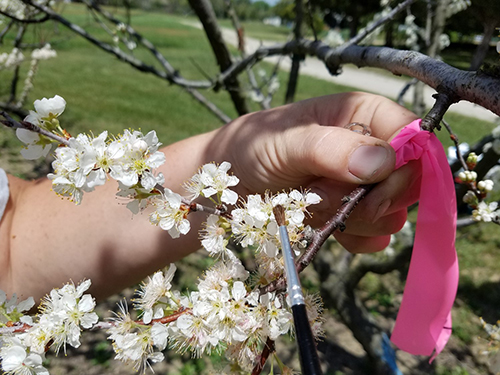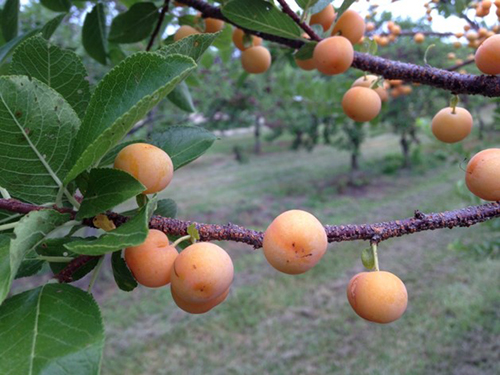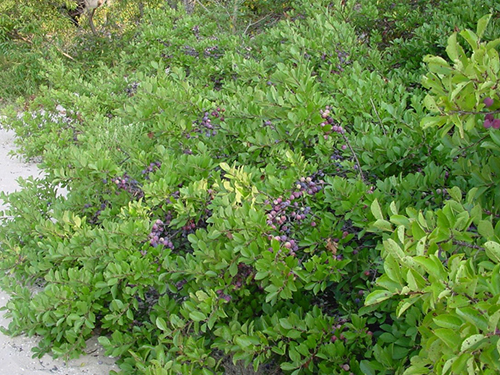
Fact Sheet FS1314
Beach plum is a native plant to the Northeast and Mid-Atlantic coastal regions that is being commercialized into a fruit crop. Despite adapting originally to nutrient-poor sandy soils along the coastline, the plant responds to cultivation in the form of higher yields. Beach plums do not require sandy soil to grow, but fertile soil with a pH range of 6.5–7.0 is optimal. The fruit has been marketed to residents and visitors of coastal areas where it has traditionally been made into jams and jellies. Beach plum products are becoming more popular with consumers participating in agritourism, and usually sold in the form of value-added products, including beach plum juice, jams, jellies, salad dressings, vinegar, and wine. Beach plums can also appeal to Pick-Your-Own customers who plan to make their own jams and jellies or eat the tart, fresh fruit.
Due to high initial investment costs associated with orchard crops and several years between planting and first harvest, beach plum farmers must prepare for a heavy financial burden early on. Growers who have the ability to capitalize on the market for new or unique fruits may realize a profit from a well-managed orchard, especially when included as part of an existing operation.
This budget depends on a number of assumptions, which correspond to one particular set of production practices. Numbers can vary greatly from farm to farm, highlighting the need for farmers to adjust the budget to fit individual needs. For more information on production practices, please see Rutgers NJAES factsheet FS1180, Pruning Beach Plums for Fruit Production and Rutgers NJAES factsheet FS1297, Ultra-Niche Crops Series: Beach Plum.
The following beach plum economics information, which comes from growers in the state, other universities’ research, and typical New Jersey values, will provide a basic understanding of the costs of producing the crop. This information for beach plums should enable farmers to make informed decisions about profitability, as well as production.
Initial Investment
To begin producing beach plums, farmers must initially invest in trees and equipment, either new or used. This initial investment for a 1/3 acre orchard, available in Table 1, includes a tractor, cuttings of a desirable variety and rootstocks or grafted plants, a sprayer, a mower, irrigation, and planting tools. Altogether, using the assumptions for this “typical” budget, these costs total $30,707 for 1/3 acre. While production should be able to cover these high costs in the long-run, farmers can lower costs by sharing equipment with other crops on a larger farm or considering purchasing used equipment. Existing farms may already have this equipment, since it is basic equipment that most operations already have. Having this equipment already would reduce initial investment costs – which is the largest out of all the costs identified. With regards to establishing the orchard, this budget assumes that the farmer purchased bare-rooted, grafted plants that are 2–3 years old for $7 per plant. Additionally, it assumes a relatively narrow spacing with approximately 360 plants per acre (120 plants for 1/3 acre).
| Item | Cost | Useful Life | Annual Depreciation | My Costs |
|---|---|---|---|---|
| Shovel (2) | $100 | 5 | $20 | |
| Irrigation | $667 | 15 | $44 | |
| Tractor (Used) | $15,000 | 15 | $1,000 | |
| Sprayer | $6,000 | 10 | $600 | |
| Mower | $8,000 | 10 | $800 | |
| Plants | $840 | 20 | $42 | |
| Pruning tools | $100 | 5 | $20 | |
| Total Investment Costs | $30,707 | $2,526 |
Fixed Costs
Fixed costs, available in Table 2 for a 1/3 acre orchard, occur annually regardless of production, thus they are the same in the establishment, pre-fruiting, and production years. They include interest, repairs, taxes, insurance, land charges, dues and subscriptions, and depreciation of equipment value. We include a land rental “opportunity” cost to reflect the ownership cost of the land which we have assumed to be $100 per acre ($33 for 1/3 acre). This can vary across the state. Dues and subscriptions are memberships in professional organizations like Farm Bureau and subscriptions to trade journals and other business related publications such as the Wall Street Journal. This “typical” budget assumes that annual insurance costs $500, annual repair costs are 1.5 percent of the initial investment, and equipment has a straight-line useful life with no salvage value. Additionally, this budget assumes that production is done on only 1/3 acre. Altering this assumption by incorporating beach plum production within a larger farm would allow farmers to share fixed costs among crops, as well as mitigate gains and losses.
With these assumptions, the total fixed costs are $4,378 per year. Of these costs, by far the largest portion, accounting for $2,526, comes from depreciation, which accounts for the loss in value of a farmer’s equipment assets as they age. While this amount is quite high, farmers can reduce it by choosing to buy used equipment. However, buying used equipment would also require more maintenance costs.
| Item | Cost | My Costs | |
|---|---|---|---|
| Depreciation | $2,526 | ||
| Interest | $768 | ||
| Repairs | $461 | ||
| Taxes | $50 | ||
| Insurance | $500 | ||
| Land Charge | $33 | ||
| Dues and Subscriptions | $40 | ||
| Total Fixed Costs | $4,378 |
Variable Costs
Variable costs, available in Table 3 for a 1/3 acre orchard, change depending on how much the farmer decides to produce in a given year. In a beach plum establishment year, these costs include a soil test, fertilizer, tractor operating costs, planting labor, production labor, maintenance labor, and interest on operating capital. Altogether, these costs total approximately $986 per 1/3 acre in the establishment year.
| Item | Unit | Price | Quantity | Cost | My Costs |
|---|---|---|---|---|---|
| Materials | |||||
Soil Test |
acre | $20.00 | 1 | $20 | |
Fertilizer 34-0-0 |
lbs | $0.54 | 60 | $32 | |
Fertilizer 0-22-11 |
lbs | $0.23 | 120 | $28 | |
10% Boron |
gal | $8.00 | 0.67 | $5 | |
Tractor Use/Oil and Gasoline |
$33.55 | 10 | $336 | ||
| Labor | |||||
Planting Labor |
hours | $16.88 | 8 | $135 | |
Apply Fertilizer |
hours | $16.88 | 0.5 | $8 | |
Maintenance Labor |
hours | $16.88 | 22.2 | $375 | |
| Interest and Operating Capital | 5.00% | $47 | |||
| Total Annual Variable Costs | $986 |
In the early, pre-fruiting years, variable costs are similar to those in the establishment year, including a soil test, fertilizer, herbicide, tractor usage, production labor, maintenance labor, and interest on operating capital. Labor costs assume a base wage rate of $12.50 per hour. Benefits add another $4.38 per hour, making the true cost of labor $16.88 per hour. Altogether, annual variable costs for the pre-fruiting year total approximately $926 per 1/3 acre.
| Item | Unit | Price | Quantity | Cost | My Costs |
|---|---|---|---|---|---|
| Materials | |||||
Soil Test |
acre | $20.00 | 1 | $20 | |
Fertilizer |
|||||
Fertilizer 34-0-0 |
lbs | $0.54 | 59.4 | $32 | |
Fertilizer 0-22-11 |
lbs | $0.23 | 118.8 | $27 | |
10% Boron |
gal | $8.00 | 0.66 | $5 | |
Herbicide 1 |
pint | $20.37 | 2.2 | $45 | |
Herbicide 2 |
pint | $6.50 | 3.3 | $21 | |
Herbicide 3 |
pint | $2.13 | 3.575 | $8 | |
Tractor Use/Oil and Gasoline |
$33.55 | 9.9 | $332 | ||
| Labor | |||||
Maintenance Labor |
hours | $16.88 | 22 | $371 | |
Apply Fertilizer |
hours | $16.88 | 0.495 | $8 | |
Apply Herbicide |
hours | $16.88 | 0.7425 | $13 | |
| Interest and Operating Capital | 5.00% | $43 | |||
| Total Annual Variable Costs | $926 |
In fruit-producing years, variable costs are considerably higher than in other years, due to the cost of labor to pick and pack the fruit. The costs include a soil test, fertilizer, pesticides, herbicides, tractor usage, harvesting labor, maintenance labor, selling charge (the cost of finding a buyer and taking the product to market calculated at 4% of sales), the cost of grape lugs for harvesting, and interest on operating capital. About 80% of the grape lugs used for harvesting would be returned each year. Thus, if the farm needs 350 lugs, 70 (or 20%) would need to be purchased every year.
Assuming a base wage rate of $12.50 per hour and considering benefits, which add another $4.38 per hour, the true cost of labor would be $16.88 per hour. The assumptions for labor required per acre are that each pesticide application takes 45 minutes. However because of the time for mixing and cleanup, this might be almost as much for 1/3 acre as for one acre. Of these variable costs during production years, the largest chunk comes from labor. Due to this high cost, small adjustments in efficiency of labor can greatly reduce variable costs. This means that to get a true picture of their farm’s profitability, farmers must be sure to include the work that they perform themselves.
Based on these assumptions, annual variable costs total $3,450.
| Item | Unit | Price | Quantity | Cost | My Costs |
|---|---|---|---|---|---|
| Materials | |||||
Soil Test |
acre | $20.00 | 1 | $20 | |
Fertilizer |
|||||
Fertilizer 34-0-0 |
lbs | $0.54 | 59.4 | $32 | |
Fertilizer 0-22-11 |
lbs | $0.23 | 118.8 | $27 | |
10% Boron |
gal | $8.00 | 0.66 | $5 | |
Pesticides |
|||||
Stage 2 Part 1 |
lbs | $7.00 | 0.66 | $5 | |
Stage 2 Part 2 |
oz | $10.00 | 1.65 | $17 | |
Stage 3 to 6 |
oz | $3.25 | 3.96 | $13 | |
Stage 7 to 8 |
fl oz | $3.25 | 3.96 | $13 | |
Pre harvest |
oz | $3.85 | 1.32 | $5 | |
Herbicide 1 |
pint | $20.37 | 0.66 | $13 | |
Herbicide 2 |
pint | $6.50 | 0.99 | $6 | |
Herbicide 3 |
pint | $2.13 | 1.07 | $2 | |
Tractor Use/Oil and Gasoline |
$33.55 | 2.97 | $100 | ||
Grape lugs for harvesting |
40 lb | $11.25 | 70 | $788 | |
| Total Materials | $1,046 | ||||
| Labor | |||||
Production Labor |
hours | ||||
Soil Test |
hours | $16.88 | 1 | $17 | |
Apply Fertilizer |
hours | $16.88 | 0.74 | $13 | |
Apply Pesticides |
hours | $16.88 | 1.98 | $33 | |
Apply Herbicide |
hours | $16.88 | 0.74 | $13 | |
Maintenance |
hours | $16.88 | 6.6 | $111 | |
Pruning and Thinning |
hours | $16.88 | 23.1 | $390 | |
Mowing |
hours | $16.88 | 0.54 | $9 | |
Subtotal |
$586 | ||||
Harvesting Labor |
|||||
Picking |
hours | $16.88 | 22.4 | $379 | |
Hauling to Packing Shed |
hours | $16.88 | 4.95 | $84 | |
Packing |
hours | $16.88 | 22.4 | $379 | |
Loading, Packing, and Selling |
hours | $16.88 | 16.5 | $278 | |
Subtotal |
$1,119 | ||||
| Total Labor | $1,705 | ||||
| Selling Charge | 4.00% | $535 | |||
| Interest on Operating Capital | 5.00% | $164 | |||
| Total Variable Costs | $3,450 | ||||
| Total Fixed and Variable Costs | $7,828 | ||||
| Management Fees | $361 | ||||
| Total Costs | $8,188 |
Sales, Yields, and Returns
Sales, yields, and returns are available in Table 6 for a 1/3 acre orchard. Beach plum yields are quite variable, depending on the use of fertilizer, the plant spacing, and the age and size of the plant. This budget assumes increasing yields each year until reaching a maximum yield of 12,000 pounds in year 15 and then declining yields after that.
While beach plum prices range as well, a typical price is $1.50 per pound of fresh fruit (up to $2 for pick-your-own). If producers choose to have customers pick their own produce, there would be no harvesting costs, but would require extra management of the orchard. The following paragraphs outline yields, revenue, and returns for various stages of production assuming a price of $1.50 per pound. While returns in the first few years are negative, in the long run a farmer can profit from beach plum production.
In the establishment year, the plants produce no beach plums. With a yield of zero, revenue during this year is zero as well. On a 1/3 acre farm with these “typical” budget assumptions, a farmer should expect to lose approximately $5,369, the total of fixed and variable costs for the establishment year. Following the establishment year is a pre-fruiting year with slightly different costs. In that year, a farmer should expect to lose approximately $5,308 (Fixed cost of $4,378 + variable costs of $926 + $5 management fees).
By the time the plants are 9 years old, their generated revenue outweighs their costs. At year 15, with this budget’s robust use of fertilizer, the plants should earn an overall net positive return. Altogether, by year 20, the 1/3 acre of beach plum plants earn the farmer around $27,825, which averages $1,391 per year on this 1/3-acre plot. This could change if other crops were on the farm so that overhead costs could be spread over more crops.
Clearly, the returns on a beach plum farm change dramatically from establishment year to twentieth year, sometimes being negative and sometimes being positive. Some recommendations to reduce this financial burden include acquiring a loan that allows the farmer to pay off earlier years once the farm is profitable, or perhaps establishing the plants over multiple years to spread out costs. Once the farm is established, the farmer will want to plant some plants each year so that there are always fruit-bearing plants.
| Year | Unit | Price | Yields | Revenue | Returns | Running Total | My Yields | My Returns |
|---|---|---|---|---|---|---|---|---|
| One | lb | $1.50 | 0 | $0 | ($5,369) | ($5,369) | ||
| Two | lb | $1.50 | 0 | $0 | ($5,308) | ($10,678) | ||
| Three | lb | $1.50 | 120 | $180 | ($8,008) | ($18,686) | ||
| Four | lb | $1.50 | 1,110 | $1,665 | ($6,523) | ($25,210) | ||
| Five | lb | $1.50 | 2,100 | $3,150 | ($5,038) | ($30,248) | ||
| Six | lb | $1.50 | 3,090 | $4,635 | ($3,553) | ($33,802) | ||
| Seven | lb | $1.50 | 4,080 | $6,120 | ($2,068) | ($35,870) | ||
| Eight | lb | $1.50 | 5,070 | $7,605 | ($583) | ($36,454) | ||
| Nine | lb | $1.50 | 6,060 | $9,090 | $902 | ($35,552) | ||
| Ten | lb | $1.50 | 7,050 | $10,575 | $2,387 | ($33,165) | ||
| Eleven | lb | $1.50 | 8,040 | $12,060 | $3,872 | ($29,294) | ||
| Twelve | lb | $1.50 | 9,030 | $13,545 | $5,357 | ($23, 937) | ||
| Thirteen | lb | $1.50 | 10,020 | $15,030 | $6,842 | ($17,096) | ||
| Fourteen | lb | $1.50 | 11,010 | $16,515 | $8,327 | ($8,769) | ||
| Fifteen | lb | $1.50 | 12,000 | $18,000 | $9,812 | $1,042 | ||
| Sixteen | lb | $1.50 | 11,010 | $16,515 | $8,327 | $9,369 | ||
| Seventeen | lb | $1.50 | 10,020 | $15,030 | $6,842 | $16,210 | ||
| Eighteen | lb | $1.50 | 9,030 | $13,545 | $5,357 | $21,567 | ||
| Nineteen | lb | $1.50 | 8,040 | $12,060 | $3,872 | $25,438 | ||
| Twenty | lb | $1.50 | 7,050 | $10,575 | $2,387 | $27,825 | ||
| Twenty Year Total Return | $27,825 | |||||||
| Average Annual Return | 6,197 | $1,391 | ||||||
Additional Resources
For more information, please visit our Ultra-Niche Crops website.
Mention or display of a trademark, proprietary product, or firm in text or figures does not constitute an endorsement by Rutgers Cooperative Extension and does not imply approval to the exclusion of other suitable products or firms.
January 2020
Copyright © 2025 Rutgers, The State University of New Jersey. All rights reserved.
For more information: njaes.rutgers.edu.
Cooperating Agencies: Rutgers, The State University of New Jersey, U.S. Department of Agriculture, and Boards of County Commissioners. Rutgers Cooperative Extension, a unit of the Rutgers New Jersey Agricultural Experiment Station, is an equal opportunity program provider and employer.




 Project sponsored by the USDA-NIFA Beginner Farmer and Rancher Development Program.
Project sponsored by the USDA-NIFA Beginner Farmer and Rancher Development Program.